
- Folk Art Carved
- Culture
- African (25)
- American (19)
- American South (4)
- Americana (4)
- Appalachian (3)
- Balinese (20)
- Folk Art (25)
- Guatemalan (6)
- Haitian (3)
- Indonesian (18)
- Mexican (289)
- Native American: Us (8)
- Native Hawaiians (3)
- Navajo (4)
- Pennsylvania Dutch (30)
- Peruvian (4)
- Puerto Rican (4)
- Unknown (11)
- Western (6)
- Western Americana (5)
- Other (3253)
- Item Length
- Material
- Acrylic, Metal, Wood (4)
- Acrylic, Wood (3)
- Bone (4)
- Brass, Wood (3)
- Burlwood, Wood (5)
- Carved Wood (4)
- Coconut (5)
- Driftwood (7)
- Glass, Wood (3)
- Mahogany (3)
- Metal (7)
- Pine (5)
- Resin (9)
- Solid Wood (6)
- Stone (12)
- Wood (2206)
- Wood / Woodenware (5)
- Wood Metal (3)
- Wood, Glass (4)
- Wood, Metal (5)
- Other (1441)
- Signed
- Size
- Subject
Hand Carved Wooden Folk Art Cultural Figures Unknown Origin
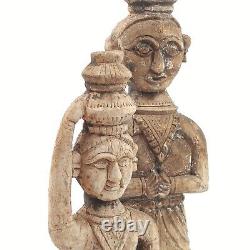

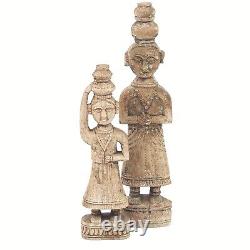
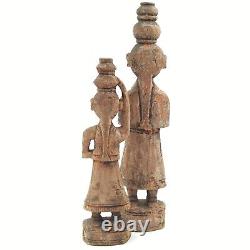

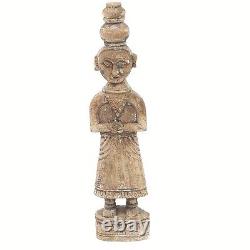

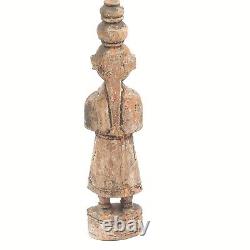


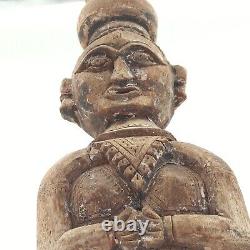



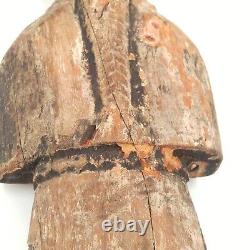





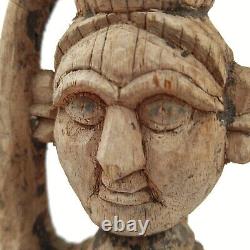


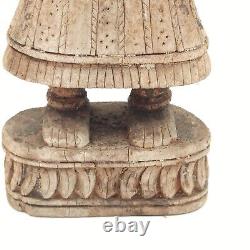


These wooden figures showcase a distinct cultural theme that appears to draw inspiration from Middle Eastern, Mediterranean, or Slavic traditions. They would be a stunning addition to an ethnographic art collection, a themed cultural display, or an interior space aiming for an antique, global ambiance. The smaller figure measures approximately 12 inches tall, with a base width of 3.25 inches and a depth of 1.5 inches. The larger figure stands at about 15.5 inches tall, with a base width of 3.75 inches and a depth of 1.75 inches. Based on their stylistic elements, wear, and overall patina, we estimate these figures could date from the early 19th century to the early 20th century, though their handmade nature and stylistic ambiguity make precise dating difficult. Surface Wear : Both figures are heavily weathered, featuring cracks and rough patches throughout. The wood has a rustic, aged appearance, with signs of exposure to varying conditions over time. Paint Remnants : Paint remnants are visible on the figures, particularly on the larger one. Traces of black paint flake off easily, revealing hints of an underlying white layer, indicating these pieces might have been repainted or adorned multiple times in their past.
Wood Details : The larger figure's wood has areas that resemble a clay-like appearance, suggesting extensive weathering and/or exposure to a mineral rich environment. The smaller figure shares a similar wood texture but is lighter in weight, which could indicate different wood types or stages of wear. Carving Details : Despite their worn state, both figures retain remarkable detail. Each has a long braided ponytail, bare feet with possible anklets, and similar clothing styles featuring a V-shaped neckline and flowing skirts. This level of attention to traditional dress and jewelry suggests a cultural or ceremonial significance.
Possible Origins & Cultural Connections. The style of dress, the braided hair, and the headpieces resembling pots or baskets could indicate that these figures are representative of women in a specific cultural context. In Middle Eastern and Mediterranean traditions, carrying objects on the head was both a daily practice and a symbolic act, often depicted in art.
The way the figures are carved-particularly their headdresses, braided hair, and flowing skirts-echoes elements found in folk art from these regions, where women were often depicted with braided hairstyles and layered clothing in carved wooden sculptures. The Slavic origin is another possibility given the facial features, postures, and the carved lines suggesting traditional attire. In some Slavic cultures, wooden carvings depicted women in ceremonial or everyday roles, often dressed in long skirts and elaborate hairstyles. The detailing on the neckline resembles traditional Slavic jewelry or clothing embellishments, suggesting that these carvings could have been created to represent women in traditional dress. Additionally, the stern facial expressions and elongated forms are reminiscent of Slavic folk art icons.
The figures' barefooted stance, possible anklets, and braided hairstyles could symbolize everyday women or culturally significant female figures. In many agrarian societies, such details are representative of cultural norms and practices, further grounding these pieces in a traditional, possibly rural, context.
The pottery or basket-like shapes atop their heads may be a nod to historic practices of carrying water or goods, which was common in these cultures. While the exact origin of these carvings remains uncertain, their rustic beauty, intricate details, and traditional elements suggest they are representations of cultural significance, possibly from the Middle Eastern, Mediterranean, or Slavic regions. Their age, condition, and craftsmanship make them a valuable piece of folk art for collectors or enthusiasts. Whether these figures depict everyday women or significant cultural icons, they exude a sense of history and tradition that makes them a remarkable find.
